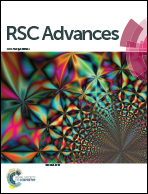Broad band thermostable polarizing film based on poly (vinyl alcohol), a quinoline derivative and ZnO nanoparticles
Abstract
In the present study, for the first time on the basis of polyvinyl alcohol (PVA), dichroic dyes: (sodium 4-[(4E)-4-[(2E)-2-(2-chloro-3-{(E)-2-[1-(4-sulfonatobutyl)quinolinium-4-yl]ethenyl}-2,3-dihydro-1H-inden-1-ylidene)ethylidene]quinolin-1(4H)-yl]butane-1-sulfonate) (I), 6-amino-4-hydroxy-3-((4-(phenyldiazenyl)phenyl)diazenyl)naphthalene-2-sulfonic acid (II), and Chicago Sky Blue (III) broad band thermostable polarizing PVA-films were created. The obtained polarizing PVA-films had polarizing efficiencies (PEs) in the range of 97–99% in UV-Vis (300–695 nm) and PEs of 90–96% in the near IR (819–855 nm) regions of the spectrum. The photostability of the films could be improved by ZnO nanoparticles (average length ∼ 1 μm and diameter ∼ 85 nm) incorporated in a polymer matrix. Apparently, ZnO NPs act as a stabilizer in the photochemical process of dye degradation. During the study, it was established that oriented broad band PVA-films are a phenomenon of the anisotropy of thermal conductivity (λ‖/λ⊥). This is very important for the existence of thermostable polarizing PVA-films. It was also found that in the films the thermal conductivity in the direction of orientation (λ‖) was higher than in a direction perpendicular to the orientation (λ⊥).


 Please wait while we load your content...
Please wait while we load your content...